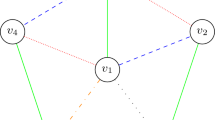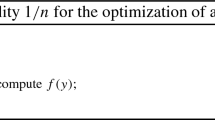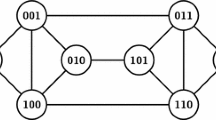Abstract
Given exponential 2n space, we know that an Adleman-Lipton computation can decide many hard problems – such as boolean formula and boolean circuit evaluation – in a number of steps that is linear in the problem size n. We wish to better understand the process of designing and comparing bio-molecular algorithms that trade away weakly exponential space to achieve as low a running time as possible, and to analyze the efficiency of their space and time utilization relative to those of their best extant classical/bio-molecular counterparts. We propose a randomized framework which augments that of the sticker model of Roweis et al. to provide an abstract setting for analyzing the space-time efficiency of both deterministic and randomized bio-molecular algorithms. We explore its power by developing and analyzing such algorithms for theCovering Code Creation (CCC) and k-SAT problems. In the process, we uncover new classical algorithms for CCC andk-SAT that, while exploiting the same space-time trade-off as the best previously known classical algorithms, are exponentially more efficient than them in terms of space-time product utilization. This work indicates that the proposed abstract bio-molecular setting for randomized algorithm design provides a logical tool of independent interest.
Similar content being viewed by others
References
Adleman LM (1994) Molecular computation of solutions to combinatorial problems. Science 266: 1021–1024
Bach E, Condon A, Glaser E and Tanguay S (1998) DNA models and algorithms for NPcomplete problems. Journal of Computer and System Sciences 57: 172–186
Chen K and Ramachandran V (2000) A space-efficient randomized DNA algorithm for k-SAT. In: Condon A and Rozenberg G (eds) DNA7 Computing, 6th International Workshop on DNA-Based Computers, Leiden, The Netherlands, June 2000, volume 2054 of LNCS, pp. 199–208. Berlin, Heidelberg
Cohen G, Honkala I, Litsyn S and Lobstein A (1997) Covering Codes. North-Holland, Amsterdam, Holland
Cormen T, Leiserson C, Rivest R and Stein S (2001) Introduction to Algorithms, second edition. McGraw-Hill.
Dantsin E, Goerdt A, Hirsch EA and Schöning U (2000b) A space-efficient randomized DNA algorithm for k-SAT. In: Montanari U, Rolim José DP and Welzl Emo (eds) Proc. 27th Coll. Automata, Languages and Programming, Geneva, Switzerland, July 2000, volume 1853 of LNCS, pp. 236–247. Springer Verlag, Berlin, Heidelberg
Dantsin E, Goerdt A, Hirsch EA, Kannan R, Kleinberg J, Papadimitriou C, Raghavan P and Schöning U (2000a) A deterministic (2-2/(k +1))” algorithm for k-SAT based on local search. Manustcipt, to appear in Theoretical Computer Science
De la Torre P (2002) How efficiently can room at the bottom be traded away for speed at the top? In: Hagiya M and Ohuchi A (eds), DNA8 Computing, 8th International Workshop on DNA-Based Computers, Sapporo, Japan, June 2002, volume 2568 of LNCS, pp. 95–111. Springer Verlag, Berlin, Heidelberg, New York
Diaz S, Esteban JL and Ogihara M (2000) A DNA-based random walk method for solving k-SAT. In: Condon A and Rozenberg G (eds) DNA7 Computing, 6th InternationalWorkshop on DNA-Based Computers, Leiden, The Netherlands, June 2000, volume 2054 of LNCS, pp. 209–219. Berlin, Heidelberg
Hartmanis J (1995) On the weight of computations. Bulletin of the European Association for Theoretical Computer Science, volume 55 (February), pp. 136–138
Feynman RP (1961) There's plenty of room at the bottom. A DNA-based random walk method for solving k-SAT. In: Gilber DH (ed) Miniaturization, pp. 282–296. Reinhold New York
Kannan R, Kleingberg J, Papadimitriou C and Raghavan P (2000) A deterministic algorithm for satisfiability. Manuscript. Web accessible in April of 2000
Lipton RJ (1995) DNA solution of hard computational problems. Science 268: 542–545
MacWilliams FJ and Sloane NJA (1977) The Theory of Error-Correcting Codes. North-Holland, Amsterdam, Holland
Paturi R, Pudlak P and Zane F (1997) Satisfiability coding lemma. In 38th Annual Symposium on Foundations of Computer Science, Miami Beach, Florida, Oct. 1997, pp. 566–574. IEEE Computer Society Press
Paturi R, Pudlak P, Saks ME and Zane F (1998) An improved exponential-time algorithm for k-SAT. In 39th Annual Symposium on Foundations of Computer Science, Palo Alto, California, Nov. 1998, pp. 628–637. IEEE Computer Society Press
Papadimitriou CH (1991) On selecting a satisfying truth assignment. In: 32nd Annual Symposium on Foundations of Computer Science, 1991, pp. 163–169. IEEE Computer Society Press
Roweis S, Winfree E, Burgoyne R, Chelyapov NV, Goodman MF, Rothemund PWK and Adleman LM (1998) A sticker-based model for DNA computation. Proceedings of the Second Annual Meeting on DNA Based Computers, June 10-12, 1996, pp. 1–27. Journal of Computational Biology 5(4): 615-629
Schöning U (1999) A probabilistic algorithm for k-SAT and constraint satisfaction problems. Proceedings of 40th Symposium on Foundations of Computer Science, pp. 410–414. IEEE Computer Society Press
Author information
Authors and Affiliations
Rights and permissions
About this article
Cite this article
de la Torre, P. How efficiently can room at the bottom be traded away for speed at the top?. Natural Computing 2, 349–389 (2003). https://doi.org/10.1023/B:NACO.0000006776.97214.c5
Issue Date:
DOI: https://doi.org/10.1023/B:NACO.0000006776.97214.c5




